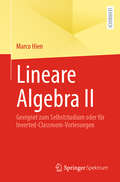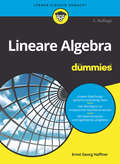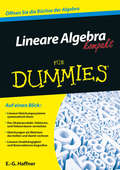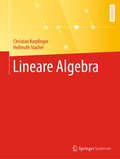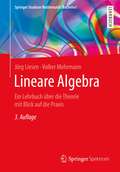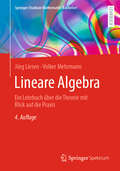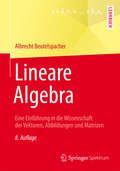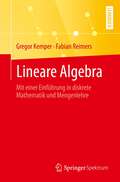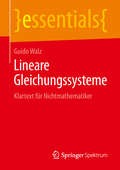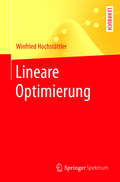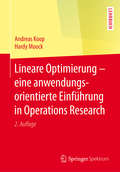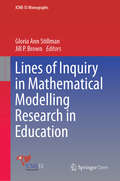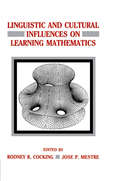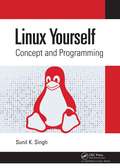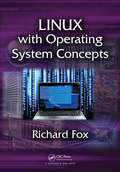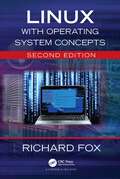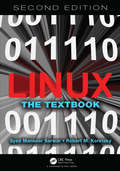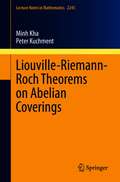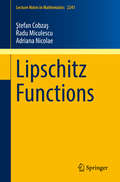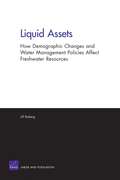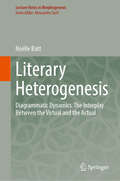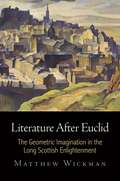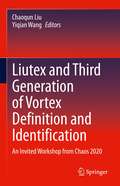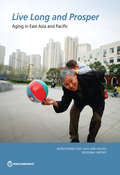- Table View
- List View
Lineare Algebra II: Geeignet zum Selbststudium oder für Inverted-Classroom-Vorlesungen
by Marco HienDieses Lehrbuch behandelt übliche Inhalte der Vorlesung "Lineare Algebra 2". Ein besonderer Schwerpunkt wird auf die schrittweise Entwicklung der Grundbegriffe, Konzepte und Sätze gelegt. Das Buch enthält eine Vielzahl von Motivationen und Querbezügen zwischen konkreten (Rechen-)Beispielen und abstrakten Aussagen und eignet sich daher hervorragend zum Selbststudium und zur Prüfungsvorbereitung. Als teilweise schwierig geltende Themen wie die Jordan-Normal-Form oder Tensorprodukte werden ausführlich motiviert und erklärt.
Lineare Algebra für Dummies (Für Dummies)
by Ernst Georg HaffnerDieses Buch wird Sie sanft in eines der wichtigsten Teilgebiete der Mathematik begleiten. Folgerichtig beginnt es mit den Grundlagen - komplexe Zahlen, Körper, Vektorrechnung -, bevor es sich linearen Gleichungssystemen und Matrizen zuwendet. Auf den nächsten Teil dürfen Sie sich freuen: Schnitte von Ebenen und affine Abbildungen werden mit den Mitteln der linearen Algebra ganz leicht handhabbar. Und zuletzt bekommen Sie noch eine Einführung in die schwierigsten Themen der linearen Algebra: Morphismen, Determinanten, Basiswechsel, Eigenwerte und -vektoren und Diagonalisierung.
Lineare Algebra kompakt für Dummies (Für Dummies)
by Ernst Georg HaffnerDer schnelle Überblick für Schüler, Studenten und jeden, den es sonst noch interessiert Sie ist unbeliebt und gilt als schwer verständlich: die Li‑neare Algebra. Aber keine Sorge, Hilfe naht: E.-G. Haffner hat für Sie das Wichtigste kompakt und dennoch verständlich zusammengefasst. Dank vieler Beispiele und Schritt-für-Schritt-Beschreibungen erlernen Sie den Umgang mit Vektoren, Vektorräumen, Matrizen und linearen Gleichungssystemen fast wie von selbst. Damit ist Lineare Algebra kompakt für Dummies der perfekte Nachhilfelehrer für die Tasche: einfach, kompetent und günstig.
Lineare Algebra: Analysis Und Lineare Algebra Mit Querverbindungen
by Christian Karpfinger Hellmuth StachelDieses vierfarbige Lehrbuch wendet sich an Studierende der Mathematik, der Physik und Informatik in Bachelor- und Lehramts-Studiengängen. Es bietet ein lebendiges Bild der Linearen Algebra, wie sie üblicherweise im ersten Studienjahr behandelt wird. Studierende der Mathematik und der mathematiknahen Studiengänge finden wichtige Begriffe, Sätze und Beweise ausführlich und mit vielen Beispielen erklärt und werden an grundlegende Konzepte und Methoden herangeführt. Im Mittelpunkt stehen das Verständnis der mathematischen Zusammenhänge und des Aufbaus der Theorie sowie die Strukturen und Ideen wichtiger Sätze und Beweise. Es wird nicht nur ein in sich geschlossenes Theoriengebäude dargestellt, sondern auch verdeutlicht, wie es entsteht und wozu die Inhalte später benötigt werden. Herausragende Merkmale sind: durchgängig vierfarbiges Layout mit mehr als 150 Abbildungen prägnant formulierte Kerngedanken bilden die Abschnittsüberschriften ausführliche Übungsbeispiele laden zum „Learning by Doing“ ein Selbsttests in kurzen Abständen ermöglichen Lernkontrollen während des Lesensfarbige Merkkästen heben das Wichtigste hervor„Hintergrund-und-Ausblick“-Boxen stellen Zusammenhänge zu anderen Gebieten und weiterführenden Themen herÜbersichtsboxen fassen wichtige Resultate zusammen.mehr als 250 Verständnisfragen, Rechenaufgaben und Aufgaben zu Beweisen Das Buch wird allen Studierenden der Mathematik und mathematiknaher Studiengänge vom Beginn des Studiums bis in höhere Semester hinein ein verlässlicher Begleiter sein. Die Inhalte dieses Buches basieren größtenteils auf dem Werk „Grundwissen Mathematikstudium – Analysis und Lineare Algebra mit Querverbindungen“, werden aber wegen der curricularen Bedeutung hiermit in vollständig überarbeiteter Form als eigenständiges Werk veröffentlicht.
Lineare Algebra: Ein Lehrbuch über die Theorie mit Blick auf die Praxis (Springer Studium Mathematik (Bachelor))
by Volker Mehrmann Jörg LiesenDieses Lehrbuch über die Lineare Algebra deckt den gesamten Stoff der zweisemestrigen Grundvorlesung ab. Seine anschauliche und konsequent matrizenorientierte Herangehensweise ermöglicht Studierenden ein intuitives Verständnis der abstrakten Objekte. Die im Buch präsentierten vielfältigen Anwendungen und Beispiele motivieren Studierende zur intensiven Auseinandersetzung mit der Linearen Algebra als leistungsfähiges mathematisches Werkzeug. In vielen „MATLAB-Minuten“ können sich Studierende wichtige Sätze und Konzepte am Rechner erarbeiten. Alle notwendigen Vorkenntnisse werden in einer MATLAB-Kurzeinführung erläutert. Das Buch enthält zudem über 350 Übungsaufgaben, die das Erlernen des Stoffes unterstützen. Interessierte Studierende finden darüber hinaus historische Notizen zur Entwicklung des Gebiets. Für diese dritte Auflage wurde die zweite Auflage durchgesehen und ergänzt. Zu den Ergänzungen gehören Abschnitte über die vollständige Induktion und die Existenz von Basen und von Adjungierten in unendlichdimensionalen Vektorräumen. Der übersichtliche Aufbau und das bewährte Konzept des Lehrbuchs wurden beibehalten.
Lineare Algebra: Ein Lehrbuch über die Theorie mit Blick auf die Praxis (Springer Studium Mathematik (Bachelor))
by Volker Mehrmann Jörg LiesenDieses Lehrbuch über die Lineare Algebra deckt den gesamten Stoff der zweisemestrigen Grundvorlesung ab. Seine anschauliche und konsequent matrizenorientierte Herangehensweise ermöglicht Studierenden ein intuitives Verständnis der abstrakten Objekte. Die im Buch präsentierten vielfältigen Anwendungen und Beispiele motivieren Studierende zur intensiven Auseinandersetzung mit der Linearen Algebra als leistungsfähiges mathematisches Werkzeug. In vielen „MATLAB-Minuten“ können sich Studierende wichtige Sätze und Konzepte am Rechner erarbeiten. Alle notwendigen Vorkenntnisse werden in einer MATLAB-Kurzeinführung erläutert. Das Buch enthält zudem über 350 Übungsaufgaben, die das Erlernen des Stoffes unterstützen. Interessierte Studierende finden darüber hinaus historische Notizen zur Entwicklung des Gebiets. Für diese vierte Auflage wurde das Buch durchgesehen und ergänzt. Zu den Ergänzungen gehören insbesondere die genauere Betrachtung von Projektionen, die Herleitung der Frobenius-Normalform von Endomorphismen sowie der Beweis eines wichtigen Satzes über Matrixfunktionen basierend auf der Lösung des Hermite-Interpolationsproblems. Hinzugekommen sind außerdem mehr als 20 neue Aufgaben sowie Begriffe wie der Bidualraum, derogatorische Matrizen, Invariantenteiler und Isometrien. Der übersichtliche Aufbau und das bewährte Konzept des Lehrbuchs wurden beibehalten.
Lineare Algebra: Eine Einführung in die Wissenschaft der Vektoren, Abbildungen und Matrizen
by Albrecht BeutelspacherDieses Lehrbuch ist leicht verständlich, speziell für Anfänger der Mathematik sowohl im Bachelor- als auch im Lehramtsstudium. Unter den vielen Büchern über Lineare Algebra, die Sie in der Bibliothek oder einer Buchhandlung finden, eignet dieses sich besonders dafür, Ihr erstes Mathematikbuch zu sein.Der Stil ist locker, lustig, leicht und unterhaltsam. Vor allem wurde versucht, die üblichen k.o.-Schläge, wie etwa "wie man leicht sieht", "trivialerweise folgt", "man sieht unmittelbar", zu vermeiden.Durch viele Lernhilfen ist das Buch ideal geeignet zum Selbststudium: Zu jedem Kapitel gibt es zunächst eine Reihe von insgesamt über 250 "ganz dummen" Fragen, die zur unmittelbaren Kontrolle dienen; dann gibt es eine reiche Auswahl von leicht lösbaren Übungsaufgaben und schließlich tiefergehende "Projekte". Alles in allem über 300 Übungsaufgaben - mit Tipps zu ihrer Lösung. Das Buch liegt nun in einer verbesserten und neu gesetzten Neuauflage vor.
Lineare Algebra: Mit einer Einführung in diskrete Mathematik und Mengenlehre
by Gregor Kemper Fabian ReimersLineare Algebra auf den Punkt gebracht Dieses Buch ist bestens geeignet für Studierende als Begleitlektüre und für Lehrende als Grundlage zur Vorlesungsplanung. Es zeichnet sich aus durch eine präzise Darstellung ohne Ausschweifungen. Einzigartig ist die Kombination dreier „Handlungsstränge“: Lineare Algebra (als Hauptstrang), diskrete Mathematik und Mengenlehre. Dabei kann der Hauptstrang unabhängig von den beiden anderen Strängen gelesen werden, die jeweils eine solide Einführung in ihre Stoffgebiete beinhalten. Auf diese Weise lassen sich die Nebenstränge in eine gemeinsame Vorlesung mit der Linearen Algebra integrieren oder bleiben ein optionales Zusatzangebot zur Linearen Algebra für Ergänzungen oder Seminare. Mit über 350 Aufgaben bietet das Buch bei jedem Themengebiet die Gelegenheit zur aktiven Auseinandersetzung mit dem Stoff an. Die Bandbreite umfasst neben vorlesungsbegleitenden Übungsaufgaben auch typische Klausuraufgaben und größere Aufgabenprojekte. Für einige der Aufgaben sind zudem Lösungsvideos verfügbar.
Lineare Algebra: leicht gemacht!
by Jochen BallaDas vorliegende Buch bietet eine leicht lesbare Darstellung der Kerninhalte der Linearen Algebra. Es richtet sich an Studierende der Natur- und Ingenieurwissenschaften, der Wirtschaftswissenschaften und allgemein aller Fachgebiete, in denen Vektoren und Matrizen eine Rolle spielen. Auch Mathematikstudierenden, die einen leicht verständlichen Zugang suchen, leistet es gute Dienste.Der Schwerpunkt der Darstellung betrifft endlichdimensionale Vektorräume: Die Vektoren entsprechen n-Tupeln und Basistransformationen und Abbildungen werden durch n × n-Matrizen beschrieben. Die Rechenoperationen für Matrizen werden vollständig aus den entsprechenden Operationen für Abbildungen entwickelt.Die Theorie wird anhand zahlreicher Beispiele eingeübt und angewendet. Geometrische Anwendungen im zwei- und dreidimensionalen Raum spielen dabei naturgemäß eine besondere Rolle.Das Lehrbuch bietet verschiedene Hilfestellungen, die den Zugang erleichtern:139 Lesehilfen helfen über schwierige Stellen hinweg37 Zwischenfragen mit Antworten regen zum Nachdenken an51 Übungsaufgaben mit ausführlichen Lösungen unterstützen das vertiefende Studium„Das Wichtigste in Kürze“ und eine Formelsammlung fassen am Ende eines jeden Kapitels den Inhalt zusammen.
Lineare Gleichungssysteme: Klartext für Nichtmathematiker (essentials)
by Guido WalzDieses Buch vermittelt in leicht verständlicher Sprache Techniken zum Lösen linearer Gleichungssysteme. Der Fokus liegt dabei auf dem Gauß-Verfahren, da man hiermit Systeme beliebiger Größe und Form vollständig lösen kann. Die ersten beiden Kapitel sind der Behandlung quadratischer Systeme mit zwei oder drei Unbekannten gewidmet, um dem Leser die prinzipielle Vorgehensweise zu schildern. Darauf aufbauend wird das Gauß-Verfahren für Systeme beliebiger Größe – quadratische und nicht-quadratische – geschildert und anhand zahlreicher Beispiele illustriert. Der Darstellung der Lösungsmenge von Systemen mit unendlich vielen Lösungen ist ein eigener Abschnitt gewidmet. Weiterhin werden Strategien zur Behandlung von Textaufgaben, die auf lineare Gleichungssysteme führen, aufgezeigt.
Lineare Optimierung
by Winfried HochstättlerDieses einführende Lehrbuch wendet sich vor allem an Studierende der Mathematik, Wirtschaftsmathematik und Informatik und bietet den Lesern einen verständlichen Überblick über das weite Feld der Linearen Optimierung. Hierbei werden neben klassischen Themen zur Modellierung, Polyedertheorie und zum Simplexalgorithmus auch komplexitätstheoretische Aspekte sowohl des Simplexalgorithmus wie auch der polynomialen Verfahren zur Linearen Optimierung intensiv behandelt. Letztere haben ihren Ursprung zwar in der nicht-linearen Optimierung und galten bei Ihrer Entdeckung vor 40 Jahren zunächst als eher von theoretischem Wert. Heutzutage kommt aber keine kommerzielle Software zur Linearen Optimierung an diesen Verfahren vorbei. Das Buch ist aus einem Studienbrief der FernUniversität in Hagen hervorgegangen und deswegen insbesondere auch für das Selbststudium geeignet.
Lineare Optimierung – eine anwendungsorientierte Einführung in Operations Research
by Andreas Koop Hardy MoockLeicht verständlich und praxisorientiert behandelt das vorliegende Buch die wesentlichsten Gebiete der Linearen Optimierung, einem Kernbereich des Operations Research. Es wendet sich an Studierende betriebswirtschaftlicher und technischer Disziplinen. Aber auch der Praktiker aus kleinen und mittelständischen Unternehmen wird in hohem Maße davon profitieren. Da kaum mathematische Kenntnisse vorausgesetzt werden, fällt es gerade ihm leicht, sich selbstständig in die Lineare Programmierung einzuarbeiten, die erhebliche Kostensenkungen und Zeiteinsparungen ermöglicht. Auch Studierende der Mathematik und der Informatik werden durch das Buch angesprochen, da sie sehr schnell einen Überblick über die Lineare Programmierung gewinnen können. Kurz und prägnant, dabei vollständig und mathematisch exakt, werden die Methoden hergeleitet, rezeptartig zusammengefasst, durch zahlreiche Beispiele und Übungsaufgaben ergänzt und mit zwei Fallstudien aus der betriebswirtschaftlichen und technischen Praxis angereichert. Nicht zu vergessen die softwaretechnische Umsetzung der Linearen Programme mittels Excel-Solver bzw. der Programmiersprache C. Dieses Buch ist ein Muss für jeden, der in die Thematik der Linearen Optimierung einsteigen möchte.
Lines of Inquiry in Mathematical Modelling Research in Education (ICME-13 Monographs)
by Gloria Ann Stillman Jill P. BrownThis open access book is based on selected presentations from Topic Study Group 21: Mathematical Applications and Modelling in the Teaching and Learning of Mathematics at the 13th International Congress on Mathematical Education (ICME 13), held in Hamburg, Germany on July 24–31, 2016. It contributes to the theory, research and teaching practice concerning this key topic by taking into account the importance of relations between mathematics and the real world. Further, the book addresses the “balancing act” between developing students’ modelling skills on the one hand, and using modelling to help them learn mathematics on the other, which arises from the integration of modelling into classrooms. The contributions, prepared by authors from 9 countries, reflect the spectrum of international debates on the topic, and the examples presented span schooling from years 1 to 12, teacher education, and teaching modelling at the tertiary level. In addition the book highlights professional learning and development for in-service teachers, particularly in systems where the introduction of modelling into curricula means reassessing how mathematics is taught. Given its scope, the book will appeal to researchers and teacher educators in mathematics education, as well as pre-service teachers and school and university educators
Linguistic and Cultural Influences on Learning Mathematics (Psychology of Education and Instruction Series)
by Jose P. Mestre Rodney R. CockingThe combined impact of linguistic, cultural, educational and cognitive factors on mathematics learning is considered in this unique book. By uniting the diverse research models and perspectives of these fields, the contributors describe how language and cognitive factors can influence mathematical learning, thinking and problem solving. The authors contend that cognitive skills are heavily dependent upon linguistic skills and both are critical to the representational knowledge intimately linked to school achievement in mathematics.
Linux Yourself: Concept and Programming
by Sunil K. SinghNumerous people still believe that learning and acquiring expertise in Linux is not easy, that only a professional can understand how a Linux system works. Nowadays, Linux has gained much popularity both at home and at the workplace. Linux Yourself: Concept and Programming aims to help and guide people of all ages by offering a deep insight into the concept of Linux, its usage, programming, administration, and several other connected topics in an easy approach. This book can also be used as a textbook for undergraduate/postgraduate engineering students and others who have a passion to gain expertise in the field of computer science/information technology as a Linux developer or administrator. The word "Yourself" in the title refers to the fact that the content of this book is designed to give a good foundation to understand the Linux concept and to guide yourself as a good Linux professional in various platforms. There are no prerequisites to understand the contents from this book, and a person with basic knowledge of C programming language will be able to grasp the concept with ease. With this mindset, all the topics are presented in such a way that it should be simple, clear, and straightforward with many examples and figures. Linux is distinguished by its own power and flexibility, along with open-source accessibility and community as compared to other operating systems, such as Windows and macOS. It is the author’s sincere view that readers of all levels will find this book worthwhile and will be able to learn or sharpen their skills. KEY FEATURES Provides a deep conceptual learning and expertise in programming skill for any user about Linux, UNIX, and their features. Elaborates GUI and CUI including Linux commands, various shells, and the vi editor Details file management and file systems to understand Linux system architecture easily Promotes hands-on practices of regular expressions and advanced filters, such as sed and awk through many helpful examples Describes an insight view of shell scripting, process, thread, system calls, signal, inter-process communication, X Window System, and many more aspects to understand the system programming in the Linux environment Gives a detailed description of Linux administration by elaborating LILO, GRUB, RPM-based package, and program installation and compilation that can be very helpful in managing the Linux system in a very efficient way Reports some famous Linux distributions to understand the similarity among all popular available Linux and other features as case studies
Linux with Operating System Concepts
by Richard FoxA True Textbook for an Introductory Course, System Administration Course, or a Combination Course Linux with Operating System Concepts merges conceptual operating system (OS) and Unix/Linux topics into one cohesive textbook for undergraduate students. The book can be used for a one- or two-semester course on Linux or Unix. It is complete with revie
Linux with Operating System Concepts
by Richard FoxA True Textbook for an Introductory Course, System Administration Course, or a Combination Course Linux with Operating System Concepts, Second Edition merges conceptual operating system (OS) and Unix/Linux topics into one cohesive textbook for undergraduate students. The book can be used for a one- or two-semester course on Linux or Unix. It is complete with review sections, problems, definitions, concepts and relevant introductory material, such as binary and Boolean logic, OS kernels and the role of the CPU and memory hierarchy. Details for Introductory and Advanced Users The book covers Linux from both the user and system administrator positions. From a user perspective, it emphasizes command-line interaction. From a system administrator perspective, the text reinforces shell scripting with examples of administration scripts that support the automation of administrator tasks. Thorough Coverage of Concepts and Linux Commands The author incorporates OS concepts not found in most Linux/Unix textbooks, including kernels, file systems, storage devices, virtual memory and process management. He also introduces computer science topics, such as computer networks and TCP/IP, binary numbers and Boolean logic, encryption and the GNU’s C compiler. In addition, the text discusses disaster recovery planning, booting and Internet servers. New in this Edition The book has been updated to systemd Linux and the newer services like Cockpit, NetworkManager, firewalld and journald. This edition explores Linux beyond CentOS/Red Hat by adding detail on Debian distributions. Content across most topics has been updated and improved.
Linux: The Textbook, Second Edition
by Syed Mansoor Sarwar Robert M KoretskyLinux: The Textbook, Second Edition provides comprehensive coverage of the contemporary use of the Linux operating system for every level of student or practitioner, from beginners to advanced users. The text clearly illustrates system-specific commands and features using Debian-family Debian, Ubuntu, and Linux Mint, and RHEL-family CentOS, and stresses universal commands and features that are critical to all Linux distributions. The second edition of the book includes extensive updates and new chapters on system administration for desktop, stand-alone PCs, and server-class computers; API for system programming, including thread programming with pthreads; virtualization methodologies; and an extensive tutorial on systemd service management. Brand new online content on the CRC Press website includes an instructor’s workbook, test bank, and In-Chapter exercise solutions, as well as full downloadable chapters on Python Version 3.5 programming, ZFS, TC shell programming, advanced system programming, and more. An author-hosted GitHub website also features updates, further references, and errata. Features New or updated coverage of file system, sorting, regular expressions, directory and file searching, file compression and encryption, shell scripting, system programming, client-server–based network programming, thread programming with pthreads, and system administration Extensive in-text pedagogy, including chapter objectives, student projects, and basic and advanced student exercises for every chapter Expansive electronic downloads offer advanced content on Python, ZFS, TC shell scripting, advanced system programming, internetworking with Linux TCP/IP, and many more topics, all featured on the CRC Press website Downloadable test bank, work book, and solutions available for instructors on the CRC Press website Author-maintained GitHub repository provides other resources, such as live links to further references, updates, and errata
Liouville-Riemann-Roch Theorems on Abelian Coverings (Lecture Notes in Mathematics #2245)
by Minh Kha Peter KuchmentThis book is devoted to computing the index of elliptic PDEs on non-compact Riemannian manifolds in the presence of local singularities and zeros, as well as polynomial growth at infinity. The classical Riemann–Roch theorem and its generalizations to elliptic equations on bounded domains and compact manifolds, due to Maz’ya, Plameneskii, Nadirashvilli, Gromov and Shubin, account for the contribution to the index due to a divisor of zeros and singularities. On the other hand, the Liouville theorems of Avellaneda, Lin, Li, Moser, Struwe, Kuchment and Pinchover provide the index of periodic elliptic equations on abelian coverings of compact manifolds with polynomial growth at infinity, i.e. in the presence of a "divisor" at infinity.A natural question is whether one can combine the Riemann–Roch and Liouville type results. This monograph shows that this can indeed be done, however the answers are more intricate than one might initially expect. Namely, the interaction between the finite divisor and the point at infinity is non-trivial.The text is targeted towards researchers in PDEs, geometric analysis, and mathematical physics.
Lipschitz Functions (Lecture Notes in Mathematics #2241)
by Ştefan Cobzaş Radu Miculescu Adriana NicolaeThe aim of this book is to present various facets of the theory and applications of Lipschitz functions, starting with classical and culminating with some recent results. Among the included topics we mention: characterizations of Lipschitz functions and relations with other classes of functions, extension results for Lipschitz functions and Lipschitz partitions of unity, Lipschitz free Banach spaces and their applications, compactness properties of Lipschitz operators, Bishop-Phelps type results for Lipschitz functionals, applications to best approximation in metric and in metric linear spaces, Kantorovich-Rubinstein norm and applications to duality in the optimal transport problem, Lipschitz mappings on geodesic spaces.The prerequisites are basic results in real analysis, functional analysis, measure theory (including vector measures) and topology, which, for reader's convenience, are surveyed in the first chapter of the book.
Liquid Assets
by Jill BobergMost writings linking demographic trends to water availability often look only at population-growth effects, treating water supplies as static and population as increasing, inexorably leading to a water-availability crisis. This report's more holistic view of the interaction between demographics and water resources considers more demographic and local water-availability variables. It focuses on conditions in developing countries, where these factors intersect with the fewest socioeconomic resources to mediate.
Literary Heterogenesis: Diagrammatic Dynamics. The Interplay Between the Virtual and the Actual (Lecture Notes in Morphogenesis)
by Noëlle BattThis book advances a new interdisciplinary approach that engages with the concepts of science and literature through the mediation of philosophy (with a focus on the ideas of Gilbert Simondon and Gilles Deleuze). It investigates in innovative ways the multifaceted dimensions of creation, of genesis, considered here in artistic and mathematical terms as “heterogenesis”. The dialogic interaction among the three domains generates a renewed analysis of poems selected in the work of particularly inventive poets, both French and American—Emily Dickinson, e.e. cummings and Francis Ponge—as well as the artwork of Pierre Soulages, Anna-Eva Bergman and Cy Twombly. Literary Heterogenesis. Diagrammatic Dynamics. The Interplay of the Virtual and the Actual will interest specialists of mathematics, physics, literary theory and criticism, philosophy, and epistemology. It will also attract any curious mind drawn to the bridging of disciplines and the concepts of the two cultures.
Literature After Euclid: The Geometric Imagination in the Long Scottish Enlightenment
by Matthew WickmanLiterature After Euclid tells the story of the creative adaptation of geometry in Scotland during and after the long eighteenth century. It argues that diverse attempts in literature and philosophy to explain or even emulate the geometric achievements of Isaac Newton and others resulted in innovations that modify our understanding of descriptive and bardic poetry, the aesthetics of the picturesque, and the historical novel. Matthew Wickman's analyses of these innovations in the work of Walter Scott, Robert Burns, James Thomson, David Hume, Thomas Reid, and other literati change how we perceive the Scottish Enlightenment and the later, modernist ethos that purportedly relegated the "classical" Enlightenment to the dustbin of history. Indeed, the Scottish Enlightenment's geometric imagination changes how we see literary history itself.
Liutex and Third Generation of Vortex Definition and Identification: An Invited Workshop from Chaos 2020
by Chaoqun Liu Yiqian WangThis book collects papers presented in the Invited Workshop, “Liutex and Third Generation of Vortex Definition and Identification for Turbulence,” from CHAOS2020, June 9-12, 2020, which was held online as a virtual conference. Liutex is a new physical quantity introduced by Prof. Chaoqun Liu of the University of Texas at Arlington. It is a vector and could give a unique and accurate mathematical definition for fluid rotation or vortex. The papers in this volume include some Liutex theories and many applications in hydrodynamics, aerodynamics and thermal dynamics including turbine machinery. As vortex exists everywhere in the universe, a mathematical definition of vortex or Liutex will play a critical role in scientific research. There is almost no place without vortex in fluid dynamics. As a projection, the Liutex theory will play an important role on the investigations of the vortex dynamics in hydrodynamics, aerodynamics, thermodynamics, oceanography, meteorology, metallurgy, civil engineering, astronomy, biology, etc. and to the researches of the generation, sustenance, modelling and controlling of turbulence.
Live Long and Prosper
by World BankAging is a challenge which countries in East Asia and Pacific (EAP) regions are grappling with or will soon confront. It raises many questions for policymakers ranging from potential macroeconomic impacts, to fiscal challenges of supporting pension, health and long-term care systems, and labor market implications as countries seek to promote productive aging. The urgency of the aging challenge varies across the region, but it will confront all EAP countries in time and early preparation is essential to avoid the missteps of other regions. Live Long and Prosper discusses the societal and public policy challenges and reform options for EAP countries as they address aging. It aims to strike a balance between aging optimists and pessimists. On the one hand, the impacts of aging on growth, labor markets and public spending are not the unavoidable catastrophe often feared. However, minimizing the downside risks of aging and ensuring healthy and productive aging will require proactive public policy, political leadership, and new mindsets across society. The report reviews the evidence on demographic transition in EAP and its potential macroeconomic impact. It addresses the current policy environment including pensions and social security, health, and long-term care and labor markets to assess the risks of 'business as usual'. It also suggests policy directions to promote healthy and productive aging in EAP, and emphasizes that aging is not just about older people, but requires policy and behavioral change across the life cycle.
